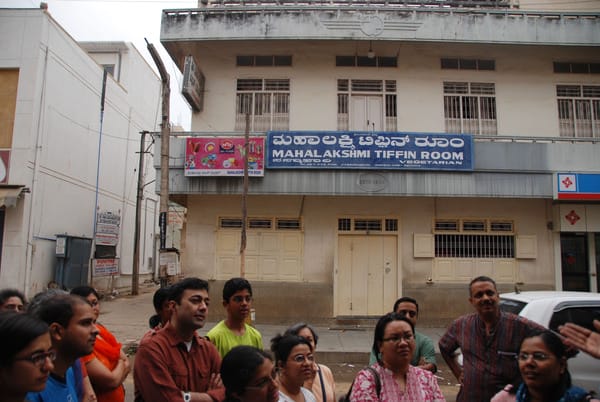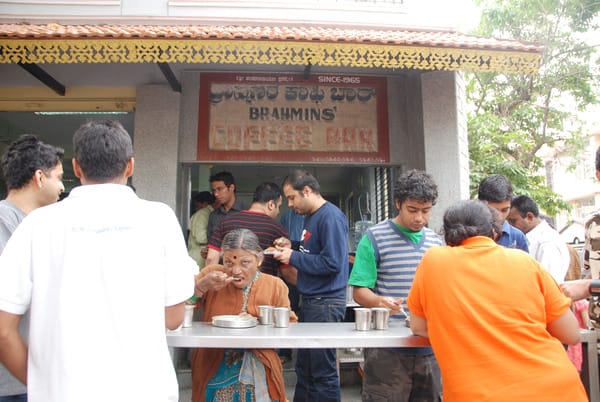The South Bangalore food walk and research commenced unexpectedly over a cup of tea with a friend – Mohan Narayan, foodie and Basavanagudiphile (I’m pretty sure he made up that word). We were talking food, one thing led to another and I had roped him in to do a food walk taking in South Bangalore’s legendary food joints. Not that he needed much convincing. So we undertook a few reconnaissance visits to joints like Vidyarthi Bhavan, Mahalakshmi Tiffin Rooms, et al, planned our route (MTR had to be dropped purely because of logistics) and the walk was ready. During this period over repeat interactions with the owners we found a treasure trove of anecdotes and facts which clearly link cuisine and culture – the link that we had sought in the first place. We convinced INTACH Bangalore of the same and our walk became a Parichay.
The Parichay, on 26th Mar 2011 commenced at Vidyarthi Bhavan on Gandhi Bazaar main road. This restaurant now owned by Ramakrishna Adiga and his son Arun, was begun by the brothers, Venkataraman and Parameshwara Ullal, hailing from Dakshina Kannada. Arun told us that though formal records date its origin to 1943, it most likely began informally in the late 1930s. The restaurant is so called as it started life as a student canteen and hence its location, mid way between National College and APS (Acharya Patha Shala), with VV College nearby.

Mahalakshmi Tiffin Room was setup in 1926. Pic: Peevee
The father-son duo recently restored the structure in a painstaking manner. Though they closed the Bhavan for just a week, the two of them put in about half a year of planning behind the works. Also they made the laudable decision (brave because of the site’s real estate worth, located in the heart of a prime commercial area) to not knock down the structure and rebuild as a commercial complex incorporating a ‘new vidyarthi bhavan’ or something similar as they felt the essence of the place would be lost. In fact when Arun’s father took over in 1970 he worked in the restaurant for a month to understand the process and recipes to ensure continuity.
Arun had other anecdotes to share with us – how he was inspired by customers who would bring their children and grandchildren to see the table or even the corner they had sat at and eaten, exclaiming over the fact that the place had not changed… Artist Vishnu Murthy started his career here and worked his way up from the kitchens to become a manager. A N Subbaramar, a patron, noticed his doodles and insisted that Vishnu Murthy attend his art school in the afternoons, when the restaurant was closed. Today the artist’s sketches of prominent personalities who visited the Bhavan adorn its walls.
Opposite to Vidyarthi Bhavan at the crossroads, was the Circle Lunch Home, (so called duplicate CLH as the original was in VV Puram), today the Ladies Wear House. According to Katte Ramachandra, theatre person and hard core Basavanagudiphile, introduced to me by Mohan, this place used to be the favourite haunt of litterateurs and could well be called the place where Kannada Sahitya developed and grew. Moving on down the road from this junction we came to M(L)TR. This restaurant was set up in 1926 by Ramakrishna Karanth and is currently managed by his son Vasudev and grandson Girish.
Girish tells us that the place was originally called Lakshmi Bhavan after his great grandmother Mahalakshmi who was instrumental in its founding. It was later rechristened Mahalakshmi Tiffin Rooms. Interestingly, Girish’s family also hails from Dakshina Kannada and on asking him about a possible link between Dakshina Kannada and restaurants, he says it’s because his community knows the art of cooking, "they know to perfection how to mix what with what". Among its more famous visitors, Girish recollects, DVG (D V Gundappa) and Nissar Ahmed (both prominent Kannada writers) sitting for hours together in the upstairs room where they no longer have service. He also remembers that earlier, customers would be seated on ‘manays’ or wooden planks, there were no tables or chairs and different communities had different seating areas.

Brahmins coffee bar, the chutney here is stuff of legends. Pic: Devi Viswanathan.
We continued down the road to Brahmins, established in its current location off Ranga Rao road, Shankarpuram in 1965. It was started by Nagesh Adiga at the persistence of his wife Saraswati. (Her father was already in Bangalore, running the ‘original’ Circle Lunch Home in V V Puram). Nagesh himself was both priest and cook and used to run the canteen at Bangalore City Institute (from 1958) before setting up Brahmins. Surprisingly or rather inevitably this family too hails from Dakshina Kannada.
Today the restaurant is managed by Nagesh’s son Radhakrishna and nephew Vishvanath. Vishavanath tells us that his grandmother Saraswati, though 79 years old, still rules the kitchen. She gets up at 4am everyday to mix chutney ingredients by hand and not surprisingly Brahmins chutney is the stuff of legends. Thus giving credence to the adage "obbobru kai guna"- not really translatable but nearest would be, "the taste depends on the hand of the person cooking the food".
Maybe that’s why regular customers at Brahmins don’t want change. In fact when they recently expanded this tiny hole in the wall, regulars insisted that the old board be retained and it was!
Our walk continued to VV Puram, past Sajjan Rao circle and Janata Tiffin Rooms (established 1966), whose regular visitors included, Netkalappa and Sethuram (news paper editor), to New Modern Hotel.
This is now both restaurant and hotel but started life as a restaurant in 1957 in a rented place nearby before moving to its current location in 1965. It was earlier called Brahmins Lunch Home, then Hongemarada Hotel and finally New Modern Hotel. ‘New’ because there used to an Old Modern Hotel down the road, since shut down.
We spoke to Prakash Adiga, current owner Padmanabha Adiga’s son who feels that the food served in such restaurants is suited to the local climate and since people don’t need to work as hard nowadays it’s better to eat such simple, easily digestible food.
However the link between cuisine and culture was really brought to focus by Katte Ramachandra. We requested him to make a comparison between these joints and here’s what he had to say, In the past Vidyarthi Bhavan was considered very expensive but it was the haunt of all national level writers and journalists. However it was tiny and smoking was not permitted so it was difficult for regulars to linger. Hence the Circle Lunch Home, opposite the Bhavan became the place to hang around. It had a room upstairs, not open to everyone, where all the poets, writers and Gnanapith awardees would congregate. He vividly recollects seeing a group of them sitting in the midst of all the smoke in this room, empathically arguing some point, on the rare occasions he was permitted entry upstairs.
Similarly, MLTR or "bhattru" hotel was also popular. Not only did it have enough room to sit and gossip, it was also affordable and it had a smoking corner in the basement. New Modern Hotel on the other hand was considered a sophisticated joint by most people. Regulars at NMH used to haunt Old Modern Hotel across the road before it shut down. NMH was popular with artistes who would either stay here or at least mingle as it was close to Benaka (Bengaluru Nagara Kalavidaru), the seminal theatre troupe, based out of RV Road.
The question now arises how does one conserve this heritage or atleast ensure its continuity? For heritage it is, these are not just any old food joints, they are irrevocably linked to cultural developments of the city. As Padmanabha Adiga questioned "tastes change but we haven’t, should we?" Something for us to ponder about …
Foodie Essentials
Vidyarthi Bhavan: 6:30am to 11:30am and 2pm to 8pm, closed on Fridays. Signature dish – Masala dosa
MLTR: 6:30am to 8:30pm, closed on Saturdays. Signature dishes – Khali dosa, rice bath, pulao
Brahmins: 6:00am to 12:00noon and 3:00pm to 7:00pm, closed on Sundays. Signature dish – idli, vada
Janata Tiffin Rooms: 6:30am to 12:00noon and 3:30pm to 7:30pm, closed on Mondays. Signature dishes – Rava Dosa and Khali Dosa
New Modern Hotel: Closed on Thursdays. Signature dishes – thate idli and bonda soup/sambar.
⊕
Well, at the same time, change is inevitable. If not the current owners, someone else down the lane may give up to the growing needs of time, and may bring these places down. How exactly or what exactly can people do to preserve heritage???
Nice one. Will visit all these places soon.
Excellent Article!!